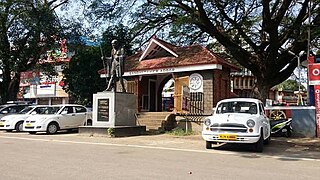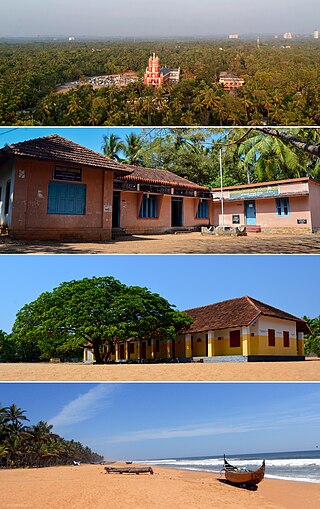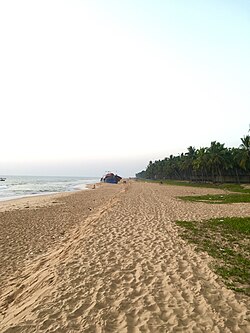
Thiruvananthapuram, formerly known as Trivandrum and T'puram, is the capital city of the Indian state of Kerala. It is the most populous and largest city in Kerala with a population of 957,730 within the city limits. Thiruvananthapuram is where Asia's first space university, the Indian Institute of Space Science and Technology is located, and India's first IT park, Technopark Thiruvananthapuram is in Thiruvananthapuram. The city also includes India’s first deep-water trans-shipment port, the Vizhinjam International Seaport Thiruvananthapuram, as well as the Sree Padmanabhaswamy Temple, known as the richest temple in the world. Thiruvananthapuram is where India's space program began, with the Vikram Sarabhai Space Centre and the headquarters of Liquid Propulsion Systems Centre located here. Thiruvananthapuram is also known for its cultural heritage, being associated with the musical contributions of Swathi Thirunal Rama Varma and the artistic legacy of painter Raja Ravi Varma.Thiruvananthapuram has contributed to the development of Malayalam literature through individuals like Ulloor S. Parameswara Iyer,Kumaran Asan, C. V. Raman Pillai and Narayana Guru. Notable beaches in Thiruvananthapuram include Kovalam, Varkala, Shankumugham Beach and Poovar. The encompassing urban agglomeration population is around 1.68 million. Located on the west coast of India near the extreme south of the mainland, Thiruvananthapuram is a major information technology hub in Kerala and contributes 55% of the state's software exports as of 2016. Referred to by Mahatma Gandhi as the "Evergreen city of India", the city is characterised by its undulating terrain of low coastal hills.

The Kingdom of Travancore, also known as the Kingdom of Thiruvithamkoor or later as Travancore State, was a kingdom that lasted from c. 1729 until 1949. It was ruled by the Travancore Royal Family from Padmanabhapuram, and later Thiruvananthapuram. At its zenith, the kingdom covered most of the south of modern-day Kerala and the southernmost part of modern-day Tamil Nadu with the Thachudaya Kaimal's enclave of Irinjalakuda Koodalmanikyam temple in the neighbouring Kingdom of Cochin. However Tangasseri area of Kollam city and Anchuthengu near Attingal in Thiruvananthapuram were parts of British India.

Nagercoil, natively spelt as Nagarkovil, is a Municipal Corporation city and the administrative headquarters of Kanyakumari District in Tamil Nadu state, India. Situated close to the tip of the Indian peninsula, it lies on an undulating terrain between the Western Ghats and the Arabian Sea.

Padmanabhapuram Palace, also known as Kalkulam Palace, is a Travancore-era palace located in Padmanabhapuram in the Kanyakumari district of the Indian state of Tamil Nadu. The palace is owned, controlled and maintained by the Kerala Government. Padmanabhapuram is the former capital city of the erstwhile kingdom of Travancore. It is around 20 km (12 mi) from Nagercoil, 39 km (24 mi) from Kanyakumari town and 52 km (32 mi) from Thiruvananthapuram in Kerala. The palace complex lies inside an old granite fortress around four kilometers long. The palace is located at the foot of the Veli Hills, part of the Western Ghats. The river Valli flows nearby.

Kazhakoottam is a major urban area in the capital city of Thiruvananthapuram, Kerala state, India. The largest IT Park of the country in terms of developed area Technopark along with Technocity an upcoming integrated IT township is situated here. Hence it is known as the Information Technology capital of Kerala. It is one of the fastest growing area of the state.

Thiruvananthapuram District is the southernmost district in the Indian state of Kerala. The district was created in 1949, with its headquarters in the city of Thiruvananthapuram, which is also Kerala's administrative centre. The present district was created in 1956 by separating the four southernmost Taluks of the erstwhile district to form Kanyakumari district. The city of Thiruvananthapuram is also known as the Information technology capital of the State, since it is home to the first and largest IT park in India, Technopark, established in 1990. The district is home to more than 9% of total population of the state.

Adoor is a municipality in the Pathanamthitta district of Kerala, India. It is the headquarters of the Adoor Taluk and Adoor Revenue Division. Adoor is located 18 km (11.2 mi) southwest of the district headquarters Pathanamthitta and 85 km (52.8 mi) north of the state capital Thiruvananthapuram.
Thuckalay or Thakkalai is a town in Kanyakumari district of Tamil Nadu, India. Thuckalay comes under the Padmanabhapuram Municipality, and is the administrative headquarters of Kalkulam Taluk. The Revenue Divisional Office is located in Mettukadai.

Puthenthope is a coastal village in Thiruvananthapuram district in Kerala, India, and situated 19 km (12 mi) northwest of city centre, 16 km from Thiruvananthapuram International Airport. The village is mostly covered with coconut palms and cashew trees. Its western side edges the Arabian Sea, while the east is separated by Parvathi Puthanar, a manmade canal completed during the time of Regent Sethu Lakshmi Bhai of Travancore Kingdom. Access to National Highway and a railway station is as short as 2 km (1.2 mi) and the VSSC of the Indian Space Research Organisation is close by. There are two man made hills — one on the south (Thekkekkunnu)and the other on the north (Vadakkekkunnu), which are believed to have been made during the time of Portuguese.India's first DNA-Barcoding Centre, set up at bio-informatic centre for Tropical Garden and Research institute at Puthenthope. Famous Malayalam Cine Artist Alencier Ley Lopez hails from Puthenthope.
Kaniyapuram is a residential and IT industrial area of Thiruvananthapuram metropolitan area of Thiruvananthapuram city around 20 kilometres (12 mi) from Thiruvananthapuram, Kerala, India. The main centre of Kaniyapuram area is located in NH-66 in between Kazhakkoottam and Pallippuram CRPF Base. The Kaniyapuram locality is a vast area and expands to; Andoorkonam in the East, Parvathy Puthanar in the West, Vetturoad in the South and Pallippuram in the North. The Kaniyapuram town belongs to the Andoorkonam Panchayat, although Andoorkonam still remains a village 3 kilometres (1.9 mi) to the east.The main town in Kaniyapuram is Alummoodu junction.
Thiruvithamcode, is a small panchayat town located in the Kanyakumari district of the Indian state of Tamil Nadu. Thiruvithamcode is about 20 km from Nagercoil and 2 km from Thuckalay.

St. Francis Xavier's Cathedral, Kottar, also known as St. Xavier Church, is a Roman Catholic Latin Rite shrine in Kottar, Nagercoil, in the Kanyakumari district of Tamil Nadu state, India. While Francis Xavier was doing missionary work in Kottar and its neighbourhood, he averted an invasion of Vadugas with the help of the army of Paravars and Padayatchi nadars of Kottar, at Vadasery, thus protecting the people of the Venad kingdom from that attack which was appreciated by the king, Unni Kerala Varma, who became closer to the priest and befriended him from then on. In recognition of Xavier’s services, the king allotted him a piece of land to construct a Catholic church, as a gesture of goodwill, as per the church records. There was already a small church, in the same place where St. Xavier’s church stands at present, dedicated to Mary the Mother of God, since AD 1544. Church records indicate that St. Xavier Church was built in 1600. In 1865, the Shrine of Mary was renovated and enlarged. In 1930, the church was raised to the status of a cathedral. The annual festival is celebrated during November – December, lasting for 10 days.
Thoothoor is a coastal village located in the Kanyakumari district in southern Tamil Nadu, India. It is located in the Taluk Killiyur, which borders the neighboring state of Kerala to the north.
Venjaramoodu is a north-east suburb of Trivandrum city, the capital of Kerala. It is 9 km (5.6 mi) east of Attingal, 11 km (6.8 mi) northwest of Nedumangad and 12 km (7.5 mi) northeast of Thiruvananthapuram City.
Thoothoor - Chinnathurai is a small village in Kanyakumari district of Tamil Nadu, at the southern tip of peninsular India Under the Parent village of Thoothoor. The two major towns nearby are Thiruvananthapuram in Kerala state to the west and Nagercoil to the east. The town is located on the coast and is historically a fishing village, specializing in catching sharks and other large fishes.

Karachi cuisine refers to the cuisine found mainly in the city of Karachi, Sindh, Pakistan. It is a multicultural cuisine as a result of the city consisting of various ethnic groups from different parts of Pakistan. Karachi is considered the melting pot of Pakistan.
Marianad is a coastal town in south Indian state of Kerala. It belongs to Kadinamkulam grama panchayat in Thiruvananthapuram district of southern Kerala. Marianad is 25 KM away from Thiruvananthapuram city which is both district headquarters and state capital. Marianad is under the area of Puthukurichy post office and PIN code is 695303.

St Ignatius Church Puthenthope, Thiruvananthapuram, is a Catholic church located in the Kadinamkulam panchayat of Thiruvananthapuram, Kerala, India. Puthenthope claims to have rich historical legacy. It is generally believed that during 1543-44 period, St. Francis Xavier visited the place and founded the church, perhaps in a rudimentary form. The church was rebuilt in 1989, with the foundation stone being blessed by Pope John Paul II during his visit to Thiruvananthapuram in 1986.
Mary Matha Shrine is a Roman Catholic church located at Thiruvithamcode in Kanyakumari District of Tamil Nadu in India. The church is also called the Church of the Ascension of our Lord or the Ascension Jesus Church and is believed to have been established by St Francis Xavier. The shrine of Mary at Thiruvithamcode is rich with its own historical significance and importance. The fact that many saints have sanctified this soil by their visit to this place also adds more importance to this place. Thiruvithamcode was previously part of the Kingdom of Travancore.

The Latin Catholics of Malabar Coast, also known as Malabar Latin Catholics or Latin Christians of Kerala are a multi-ethnic religious group in Kerala adhering to the Roman Rite liturgical practices of the Latin Church, on the Malabar Coast, the southwestern coast of India. Ecclesiastically, they constitute the ecclesiastical provinces of Verapoly and Trivandrum. They are predominantly Malayali people and speak the Malayalam language, though a subgroup of Luso-Indians speaks the Cochin Portuguese Creole. They trace their origins to the evangelization of Malabar Coast by the Dominican, Franciscan, Jesuit and Carmelite missionaries, mainly French and Portuguese.

















